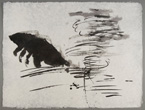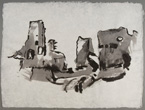Travelling in Xinjiang (China) 2007
 In May and June of 2007 Joanne and I travelled to the northwest of China, via Beijing to Lanzhou, the capital of Gansu Province. Here we visited the recently restored Provincial Museum, mainly to see the "Flying horse of Wuwei".
In May and June of 2007 Joanne and I travelled to the northwest of China, via Beijing to Lanzhou, the capital of Gansu Province. Here we visited the recently restored Provincial Museum, mainly to see the "Flying horse of Wuwei".
 This beautiful bronze horse from the Han Dynasty, resting with one hoof on the back of a swallow, was dug up in 1974 in Wuwei and is the highlight of the collection. Lanzhou was also the ideal starting point for the trip to the Taklamakan Desert, stopping on the way in Wuwei and Zhangye (Marco Polo lived here in 1271) and in Jiayuguan to visit the Fort, an enormous structure, originally built in 1372 at the most western extremes of the Chinese empire. Here we experienced our first sandstorm.
This beautiful bronze horse from the Han Dynasty, resting with one hoof on the back of a swallow, was dug up in 1974 in Wuwei and is the highlight of the collection. Lanzhou was also the ideal starting point for the trip to the Taklamakan Desert, stopping on the way in Wuwei and Zhangye (Marco Polo lived here in 1271) and in Jiayuguan to visit the Fort, an enormous structure, originally built in 1372 at the most western extremes of the Chinese empire. Here we experienced our first sandstorm.
 Then on by bus to Dunhuang and the Mogao Caves with their moving Buddhist sculptures and frescoes. But more important for my work were the imposing sand dunes at the edge of town. The flowing forms, especially fascinating at the end of the day, made such a deep impression that the Dunhuang series of drawings is the result.
Then on by bus to Dunhuang and the Mogao Caves with their moving Buddhist sculptures and frescoes. But more important for my work were the imposing sand dunes at the edge of town. The flowing forms, especially fascinating at the end of the day, made such a deep impression that the Dunhuang series of drawings is the result.
Travelling on by train we came to Turpan, on the edge of the Taklamakan desert. On the way I was struck by the erratically formed, elongated mountains lying row on row and seemingly asking "Donít you think Iím beautiful? See how Iíve been drawn!"
 In the vicinity of Turpan I was deeply impressed by the visits to the ruined Buddhist cities of Gaocheng and Jiaohe and this resulted in some Taklamakan drawings.
In the vicinity of Turpan I was deeply impressed by the visits to the ruined Buddhist cities of Gaocheng and Jiaohe and this resulted in some Taklamakan drawings.
Further westward lies Korla from where we took the "sleeperbus", 20 hours, through the desert from north to south, to Hotan on the Jade River. Here we enjoyed a rest in the dilapidated comfort of the Hotan Hotel and visits to the bazaar and Sunday Market where one cannot avoid the outstretched hands full of "jade". A taxi ride to the ruined city of Melikawat took us along the river where groups of people were "fishing" for the valuable stones.
Although the sun was not apparent it was hot in Hotan and a continuous desert wind blew sand and dust into the air so that you seemed to be walking through a suffocating, grey tunnel - often oppressive and certainly unforgettable.
Via Yecheng we reached Yarkand where many hours were spent wandering the old parts of the city with their characteristic rows of tall poplars and willows and low mudbrick houses, friendly inhabitants, impressive cemeteries and various sized mosques.
In the city of Kashgar, the turning point of our Taklamakan journey, we stayed in the former Russian Consulate, now part of the Seman Hotel. In the somewhat cooler evenings, on Sadikís terrace, I made my first sketches. We left Kashgar for 2 days to make an unforgettable trip along the Karakorum Highway to Lake Karagul (Black Lake) at 3800 metres. The wild landscape of the Pamir Mountain Range was an enormous contrast to what we had experienced before on the trip and profoundly striking.
Across desolate expanses of desert we travelled many hours by train to the ancient royal city of Kuqa. Nothing of its former glory remained but a taxi ride away lay the ruined Buddhist city of Subashi and the Kizil Caves. As in the other ruined cities very little of Buddhist art has survived, most of it having been devastated by the Mongols, then the Muslims and finally, stolen by Europeans round the turn of the 20th century. The caves where hermits, and later groups of monks, painted and sculpted, are situated in beautiful, wild surroundings, but as fascinating was the trip there and back. Never had I seen such a variety of rock formations. Undulating and soft forms were alternated by formations which looked as if the earth had just burst open. Rounded tops and vicious combs succeeded each other, and nothing resembled anything else while the colours were continuously changing.
After Kuqa another long train journey landed us in Urumqi, the lively capital of Xinjiang Province of which the Taklamakan is such a large part. Then, after a few days in Beijing, we flew homewards, where the drawing and later the painting were to take place.
The impressions from this journey were so profound and intense that, once back in Amsterdam, it took me months to order them in such a way that I was able to start using them for my work. But now itís "work in progress"!
